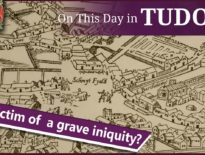21st December in Tudor times was the Feast of St Thomas the Apostle, or Didymus or Doubting Thomas. The apostle who wouldn't believe Christ had been resurrected until Christ appeared in front of him and he'd felt the nail wounds and the wound in his side.
Thomas was known for his generosity, and in Tudor times, those in need would go "a-Thomasing", collecting alms. But there are also other traditions associated with the feast day, such as pie-making. And did you know that Thomas also has links to India?
Find out more about St Thomas, his story, his feast day and the traditions associated with him, in today's talk.
Also on this day in Tudor history, 21st December 1495, Jasper Tudor, 1st Duke of Bedford and 1st Earl of Pembroke, died at his manor at Thornbury at the age of around sixty-four.
Jasper Tudor was the uncle of Henry Tudor, a man who would become King Henry VII, and served as a mentor and advisor to him.
Find out more about this interesting Tudor man in last year’s video:
Also on this day in history:
- 1505 – Birth of Thomas Wriothesley, 1st Earl of Southampton, Lord Privy Seal and Lord Chancellor to Henry VIII. He was the eldest son of William Wriothesley, York herald, and his wife, Agnes, and cousin of Charles Wriothesley, the Tudor chronicler.
- 1539 – Death of Sir John Shelton, uncle (by marriage) of Queen Anne Boleyn and Controller of the Joint Household of Mary and Elizabeth, Henry VIII's daughters from July 1536. He was buried at Shelton Church in Norfolk, in the chancel.
- 1540 (or 1542) – Birth of Thomas Allen, mathematician, astrologer and antiquary, at Uttoxeter in Staffordshire. Allen is known for his knowledge of mathematics, history and antiquity, astronomy and astrology, and philosophy. He served as Robert Dudley, Earl of Leicester's astrologer and the horoscope he cast for poet Philip Sidney can be found in the Bodleian Library's Ashmole manuscripts. His links with John Dee, Thomas Harriot and other mathematicians, combined with his knowledge of astrology, led to him being labelled a necromancer or magician.
- 1545 - William Cecil, the future Baron Burghley, married his second wife, Mildred Cooke (1526-1589), eldest daughter of Sir Anthony Cooke, Edward VI's tutor.
- 1549 - Marguerite of Navarre (also known as Margaret of Navarre, Marguerite of Angoulême and Marguerite de France) died in Odos in France at the age of fifty-seven. Marguerite was the daughter of Louise of Savoy and Charles of Orléans, Count of Angoulême, and sister of King Francis I of France.
- 1584 – Probable date for the death of John Herd, physician, author and Rector of Waddington. He was buried at Waddington. Herd had acted as Physician to Archbishop Thomas Cranmer from c.1551 until August 1555. Herd wrote a verse history of England, covering the period 1461-1509, and was also said to have written a catechism of Christian doctrine for the young.
- 1598 – Death of Thomas Owen, judge and member of Parliament. He was buried at Westminster Abbey. Owen served Elizabeth I as Serjeant-at-Law, Queen's Serjeant and Judge of the Court of Common Pleas.
- 1608 – Death of William Davison, diplomat and administrator, at Stepney. He was buried there, in St Dunstan's Church. Davison served Elizabeth I as a diplomat, carrying out embassies to the Netherlands and Scotland, and as secretary. He is mainly known for his role in the execution of Mary, Queen of Scots. Davison claimed that Elizabeth I signed Mary's death warrant and told him that she wished the execution to take place in the Great Hall of Fotheringhay Castle without delay. As instructed, Davison asked Sir Christopher Hatton, the acting Lord Chancellor, to seal the warrant with the Great Seal of England to validate it. Elizabeth, on the other hand, claimed that she had signed the warrant and then asked Davison not to disclose this fact to anyone. When she learned that it had been sealed with the Great Seal, she then asked Davison to swear on his life that he would not let the warrant out of his hands unless he had permission from her. After Mary's execution, the poor Davison was arrested, tried and sentenced to imprisonment in the Tower, and heavily fined.
Transcript:
Today, 21st December is the winter solstice and in Tudor times it was also the feast day of St Thomas the Apostle. His feast day is now commemorated on 3rd July.
Thomas, also known as Didymus, was one of the Twelve Apostles of Jesus Christ. He became known as “Doubting Thomas” because he doubted Christ’s resurrection. Here’s that story from John’s Gospel, and I’m quoting William Tyndale’s 16th century New Testament:
“But Thomas one of the twelve called Didymus was not with them when Jesus came. The other disciples said unto him: we have seen the lord. And he said unto them: except I see in his hands the print of the nails and put my finger in the holes of the nails and thrust my hand into his side, I will not believe. And after eight days again his disciples were within and Thomas with them. Then came Jesus when the doors were shut and stoode in the midst and said: peace be with you. After that said he to Thomas: bring thy finger hither and see my hands and bring thy hand and thrust it into my side and be not faithless but believing. Thomas answered and said unto him: my Lord and my God. Jesus said unto him. Thomas because thou hast seen me therefore thou believest: Happy are they that have not seen and yet believe.”
The Saint Thomas Christians in Kerala, India, trace their origins to Thomas’s evangelism in the region, as told in the Acts of Thomas in the New Testament Apocrypha and mentioned by 3rd and 4th century Roman writers. According to the 4th century Christian theologian, Ephrem the Syrian, Thomas was martyred in Chennai in India, on what is called St Thomas’s Mount, on 3rd July AD 72. Although according to another story, Thomas was killed when a fowler shot at a peac*ck and missed, hitting Thomas. Following his death, some of his relics were taken to Edessa in Mesopotamia, while others are in the San Thome Basilica in Chennai, In the 13th century, the relics in Edessa were moved to Italy, where they are housed in the Cathedral of St. Thomas the Apostle in Ortona.
St Thomas is also linked to China, Indonesia and Paraguay.
As Sophie Jackson points out in “The Medieval Christmas”, Thomas was a carpenter and “was revered for his generosity”, so on his feast day it was traditional for old women, children and the poor to “go a-Thomasing”, that is to say, walking the streets collecting alms. I know “Thomasing” can mean something quite different today though!
Another custom associated with the Feast of St Thomas in some countries is pie making. The Catholic Culture website explains that in the Tyrol, for example: “A great meat pie is baked for the whole family. It is marked with the Cross and sprinkled with holy water. Along with the great pie in the hot oven are smaller pies — one for each maid-servant in the house. When the crusts are golden brown, the pies are cooled and frozen. This is very easy to do in the bitter Tyrolean winters. Each maid takes her pie home to her family. On the feast of the Epiphany, the pies are thawed, reheated and eaten. The father of the house makes quite a ceremony of cutting the Christmas pie which is baked in a rectangular pan to resemble the manger.”
St Thomas is the patron saint of architects, and also India.
Why not celebrate his feast day today by making pies or being like Thomas and being generous to those in need? Perhaps a donation to charity in his honour.



Leave a Reply